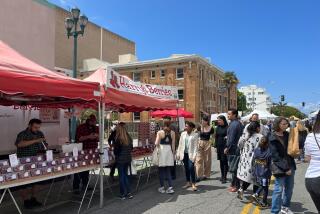Florida Freezes Over
- Share via
If you’re the kind of person who enjoys eating summer vegetables in winter, you’d better be ready to pay the price.
A freeze has devastated the Florida vegetable industry, and wholesale prices for beans, peppers, corn, tomatoes and summer squash have tripled in some cases.
Florida accounts for roughly three-quarters of the corn and beans sold in the United States in January and February, half of the eggplant, tomatoes and bell peppers and substantial amounts of cucumbers and squash.
Wholesale vegetable prices at the Los Angeles Terminal Market shot up immediately after the weekend freeze and continued to rise over the next several days as the full impact of the damage became apparent. Green beans, which had been selling for $6.50 to $7.50 a box before the freeze, immediately went to between $20 and $25, then to between $24 and $28. (The wide range in prices reflects the increased difference in quality between frost-damaged vegetables and those that escaped.)
Though there was some damage to trees and fruit, citrus prices remain largely unaffected. The record 1996-97 Florida orange crop, 90% of which is made into orange juice, is forecast to be some 2% to 3% smaller, but still better than any previous year.
Ironically, vegetable prices rose here even though few of the affected Florida crops make it to Southern California. During the winter, Los Angeles gets most of its supply of those vegetables from Mexico. In the week before the freeze, according to USDA statistics, tomatoes were the only Florida produce on the Los Angeles market, and there were less than half as many of them as there were of Mexican tomatoes.
But the more Florida prices rise, the more valuable Mexican produce becomes. Aggravating the increase is the fact that Mexico is dealing with a shorter crop than normal, having suffered a damaging freeze of its own earlier in the winter.
Prices of vegetables that are not even grown in Florida also rose. Broccoli doubled from $8 to $16 a box; cauliflower went from $8 to $14, presumably on the theory that all those corn- and squash-eaters would have to eat something.
This is the fourth year in the last five that the Florida produce industry has been hit by a major calamity. A January freeze last year produced a price hike almost as high as this one, and Hurricanes Andrew and Gordon shredded vegetable fields in September 1992 and November 1994, respectively.
More to Read
Eat your way across L.A.
Get our weekly Tasting Notes newsletter for reviews, news and more.
You may occasionally receive promotional content from the Los Angeles Times.











